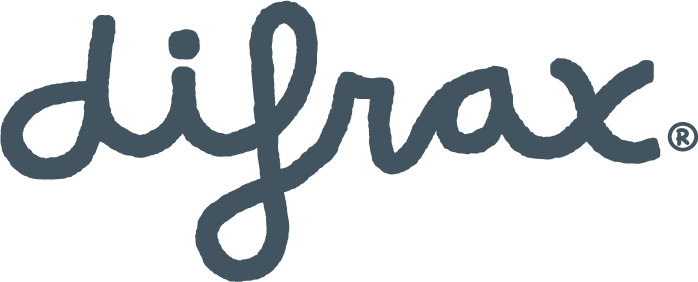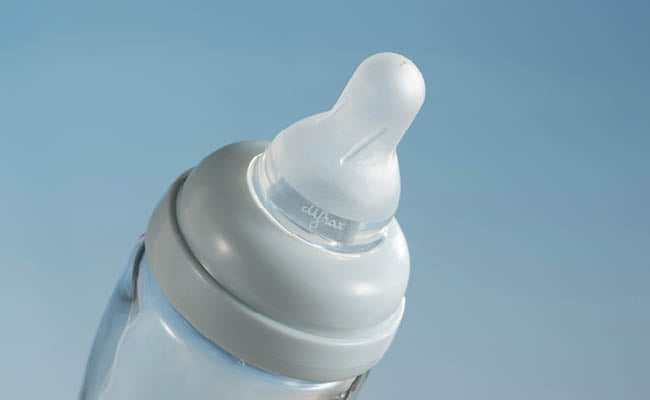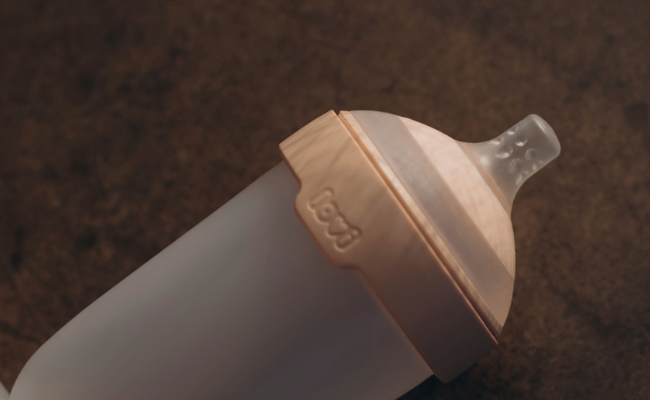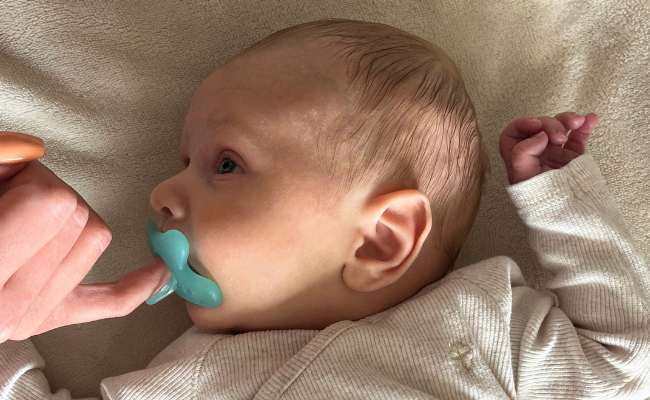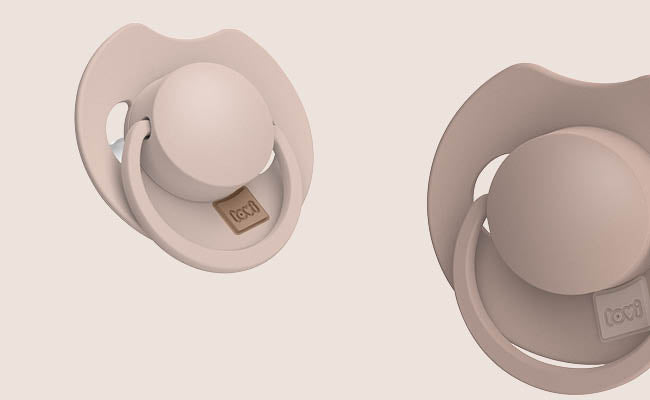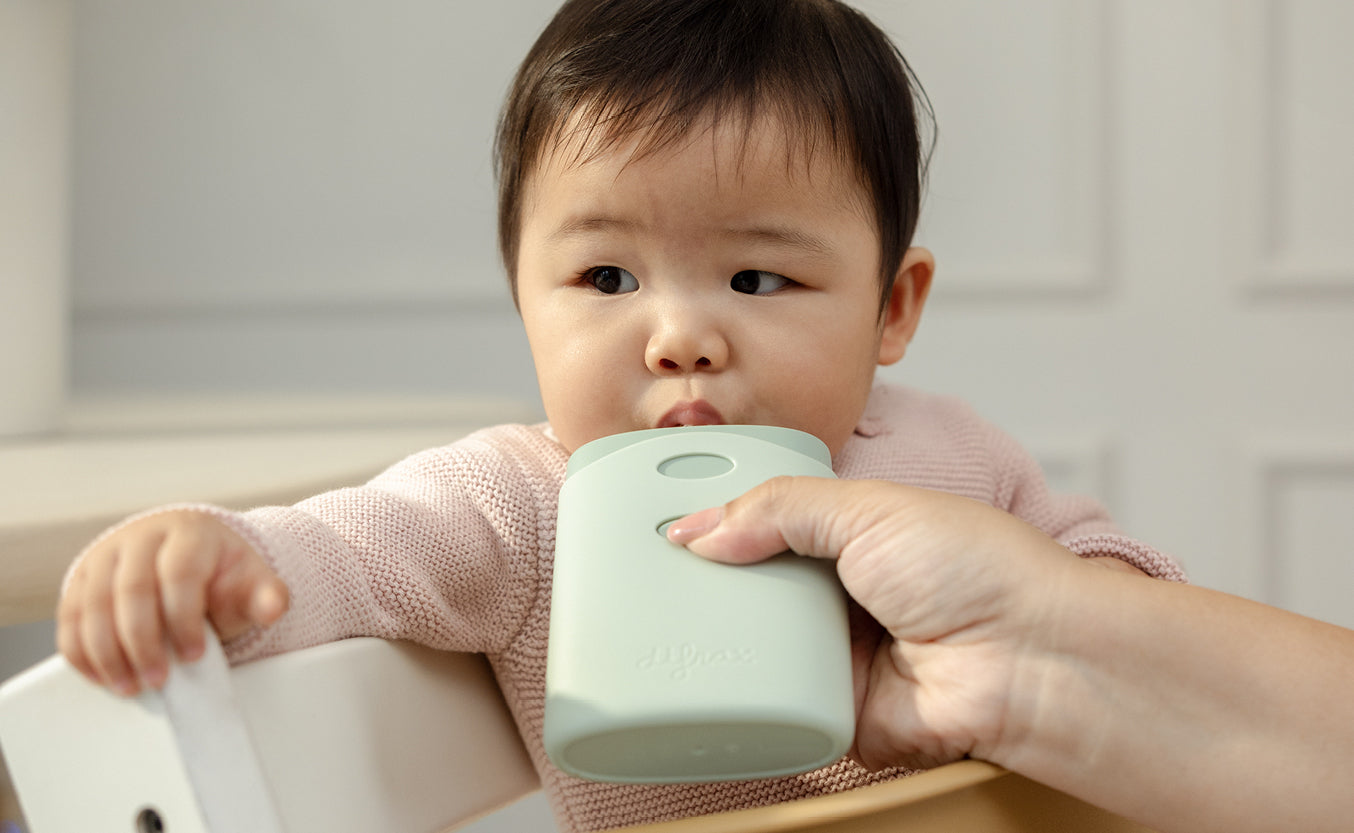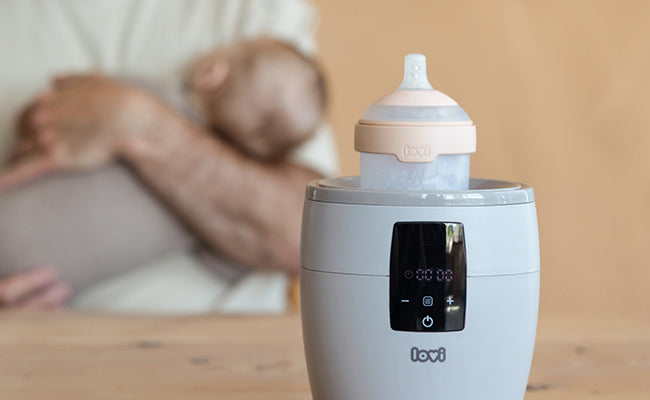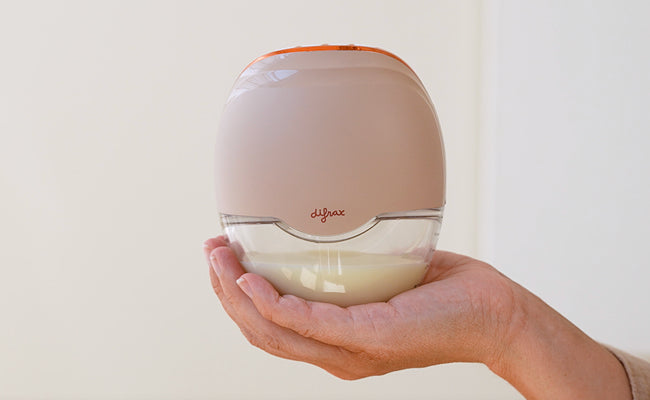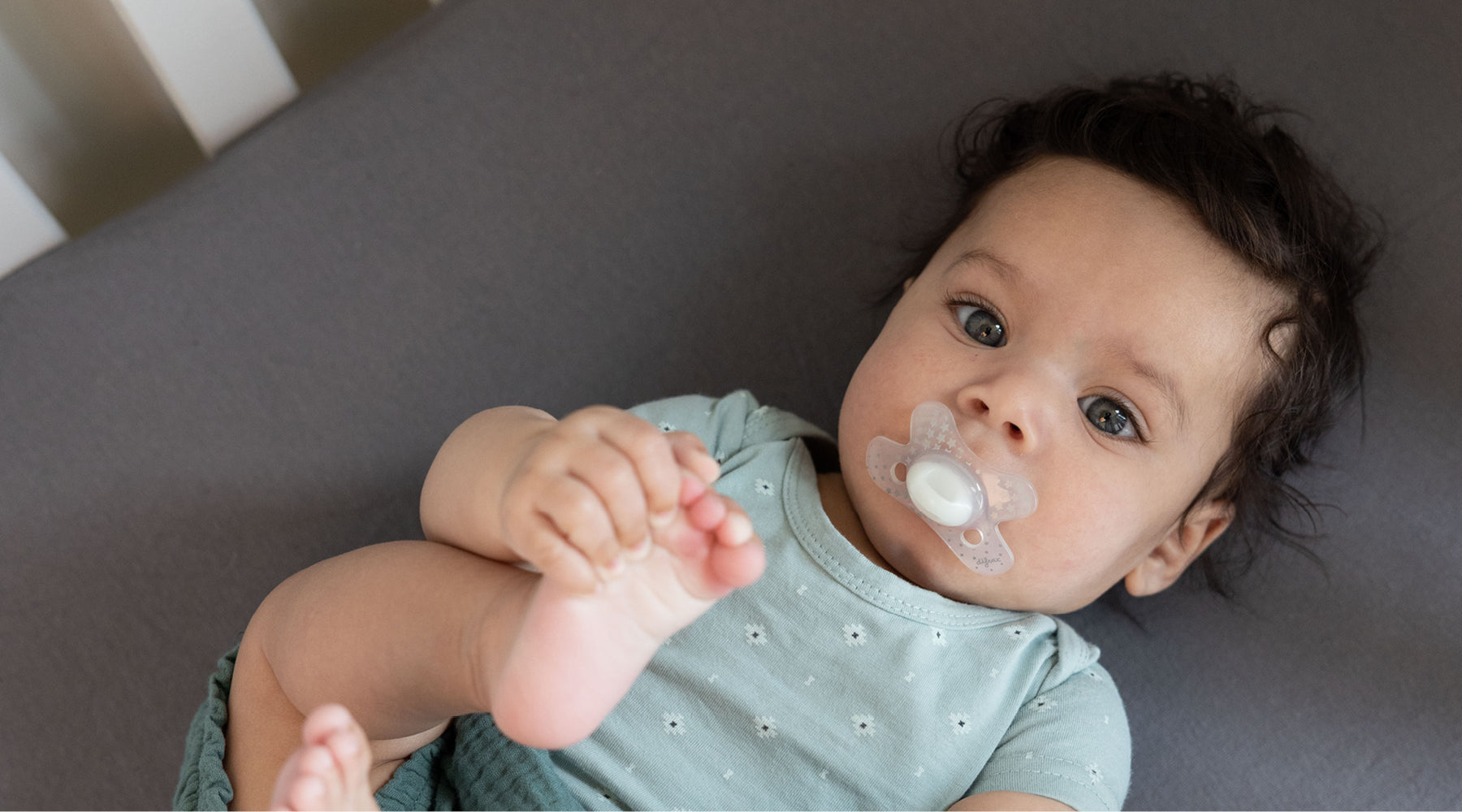
Pacifiers: which is the best pacifier for your baby?
Pacifiers come in all shapes and sizes. You have pacifiers with a plastic shield and pacifiers that are made entirely of silicone. In the suction section, you also have the choice of silicone or rubber. You obviously don't know yet whether your baby is going to be a 'pacifier' or a 'thumb' child, when he/she is in the womb. You probably already have a preference. Pacifiers, thumbs or a combination. There is something to be said about everything. When you start your layette, you will definitely come across pacifiers.
Right after birth, babies have a strong, natural sucking need. A pacifier fulfils this need and offers your baby peace and comfort. It is therefore useful to have several pacifiers, especially at the beginning. So how many pacifiers do I need? And which is suitable for my newborn? We checked it out for you and have the answers to all your questions below! By reading the following information below, you will be fully informed and prepared for when your little one is born.
The benefits of a pacifier
The main reason for giving your baby a pacifier is to soothe him. Babies have a strong sucking need in the beginning and sucking on a pacifier provides comfort and is calming and stress-relieving. So if your baby is often restless, it can be an ideal way to make sure he feels comfortable.
In hospitals, pacifiers are additionally used for premature babies or babies with starting problems. Sucking stimulates the sucking reflex, satisfies the sucking need and helps your baby, for example with tube feedings, to associate sucking with a full stomach. Babies in hospital are often more stressed, so a pacifier can help with that too.

What pacifier do I need for my newborn baby?
Babies are born with a strong sucking need so it is important to have the right pacifier. Both the Newborn and the 0-6 months pacifier are suitable for a newborn baby. Should your newborn baby have difficulty holding the pacifier or an imprint of the shield remains on baby's face, a 0-6 months pacifier is more suitable. But if your baby has difficulty with his/her sucking reflex, the Pinky pacifier is a better choice. The Difrax Pinky pacifier has a special suction part with space to place your little finger. By providing gentle support with the little finger, your little one’s sucking reflex is supported.

What's the difference between a Newborn or 0-6 months pacifier?
Difrax's Newborn pacifier is suitable for premature and newborn babies up to two months old while the 0-6 months pacifier is suitable for newborn babies up to 6 months. This is because it has a large shield. The Newborn pacifier is therefore smaller than the pacifier for 0 to 6 months.
My baby will be/is premature, which pacifier is suitable?
The Newborn pacifier is ideal for premature babies. The Newborn pacifier has been specially developed for newborn and premature babies. The pacifier is suitable for babies from -2 months old to +2 months old.

Which pacifiers does Difrax have?
Difrax has three different shapes of pacifiers. The Dental, Natural and Dynamic. The Natural pacifier has a flat base and a round/oval end. We call this symmetrical. Because of this, the pacifier is easily accepted. The Dental pacifier also has a flat base but it has another flat side to give the baby extra grip. The Dental pacifier also stimulates the development of the palate and tongue. The Dental pacifier is pleasant for babies who do not accept the Natural. Thirdly, Difrax has the Dynamic pacifier. The design of this pacifier ensures it moves with the natural sucking rhythm and mimics the mother's nipple. This pacifier also has a flat base and an oval end and is therefore also symmetrical.
The Difrax Natural pacifier has the sizes Newborn, 0-6 months, 6+ months, 12+ and 18+. The ages for the Dynamic pacifier are: Newborn, 0-3 months, 3-6 months, 6-18 months and 18+ months. Besides that, Difrax also has full silicone pacifiers. The full silicone pacifiers have a silky soft shield. This means that babies who suck very hard will not be bothered by the shield and no imprint will be left behind. The silicone pacifiers are suitable for children from 0 to 12 months.
What does the ideal pacifier look like?

1 = Suction part, in flat form
2 = Silicone material, long-lasting and does not get distorted by use
3 = Butterfly shield, its gently moulded shape sits snugly against the face
4 = Ring, easy to grasp.
1 = Teat, in a natural oval shape
2 = Silicone material, long-lasting and does not get distorted by use
3 = Butterfly shield, its gently moulded shape sits snugly against the face
4 = Ring, easy to grasp.
Why do your pacifiers have this shape shield?
The Difrax pacifier's butterfly-shaped shield is designed with baby's comfort in mind. The shield is slightly curved and has a butterfly-shaped design that fits well on the baby's face. This creates less pressure on the nose and chin. Moreover, it allows your baby to breathe freely as the nose is free from the shield.
How many pacifiers do I need for a baby?
Assuming your child uses a pacifier up to 2 years, 34 pacifiers are needed. The pacifier must be replaced every 6 weeks and you should always have a spare. For the first month, it is always handy to have a Newborn pacifier. For some babies, a 0-6 months pacifier is still too big. You will also need a spare one. You need 8 of the 0-6 months pacifier. This means that you should replace it four times in six months, including spares. The same goes for the 6+, 12+ and 18+ months pacifiers.

How long can you use a pacifier?
You can use a Difrax pacifier for six weeks. The pacifier should be replaced every six weeks. Do check it regularly. If it shows signs of damage, throw the pacifier away immediately.
Can a pacifier that is too small do any harm?
If a pacifier is too small, your baby may find it difficult to hold the pacifier in its mouth and it may leave an imprint on the face. If you see this on your baby, then you are ready for a larger size pacifier.
Can an oversized pacifier do any harm?
A pacifier that is too long or too large can hit your baby's uvula, causing him to gag. So this is not pleasant for the baby. Difrax pacifiers are also are designed so that the shield grows with the baby so it is not too big. If the shield is too large, it can end up near or over the nose. This prevents free breathing.
When to switch?
The main criterion is that your baby should be able to hold the teat in his/her mouth.
Some signs that indicate difficulty keeping the pacifier in his/her mouth:
- Your baby must make a visible effort to keep the pacifier in its mouth
- Your child quickly spits out the pacifier
- Your baby has an imprint of the shield in its cheeks
If you see one or more of these signs in your baby, it is advisable to switch to a larger size pacifier.
Read more? When to switch to a different age pacifier?.
Pacifiers in bed?
Pacifiers can certainly be used in bed. Difrax also has pacifiers that are easy to find in the dark. The glow in the dark pacifier is ideal for in bed. Pacifiers offer a relaxing effect for babies. This is ideal for a baby who has difficulty falling asleep.
Can your baby sleep with a pacifier?
Absolutely! When your baby has difficulty falling asleep, a pacifier is ideal. They offer a relaxing effect. There are even studies claiming that sleeping with a pacifier reduces the chances of cot death.

You read a lot about BPA. Are Difrax pacifiers free of this?
Yes! Difrax pacifiers, baby bottles and all other products are BPA-free.
You used to have to boil out pacifiers, do you still have to?
Yes, we recommend sterilising pacifiers before their first use. You can do this by boiling them. Want to read more about cleaning your pacifiers?
Until how old do you actually use a pacifier?
As soon as you see your baby starting to bite on the pacifier, it's time to stop. By then the natural sucking need has disappeared and the teeth are starting to form. Usually this is between 6 months and one year. For many parents and babies, it can still be difficult to phase out the pacifier at such a young age. Of course, you can then choose to keep giving the pacifier a bit longer and only phase it out when you are ready. If you don't notice that your child bites the pacifier, then the advice is to stop at 2 years. We can help you with this too, the giving up your pacifier book will help you get rid of the pacifier within 15 days.
What is the difference between your pacifier and a rubber one?
To make natural rubber (latex), a lot of chemicals are added to make it suitable. Furthermore, a pacifier made of rubber must be replaced every 4 weeks. For silicone, this is 6 weeks. Also, natural rubber pacifiers can be damaged by the heat of sunlight, sterilising and heating. They change shape easily and can cause allergic reactions in some babies. In addition, natural rubber has a taste that is not pleasant for the baby. Silicone, on the other hand, is odourless and tasteless. Silicone also tears less easily and is allergy-free. Furthermore, silicone is also resistant to the previously mentioned heat sources.
If you would like to know more, then check the log natural rubber not natural blog. Natural rubber, not so natural
A = round pacifier
B = oval Difrax pacifier
Where can I buy a pacifier?
You can find pacifiers in almost every drugstore, such as Kruidvat and Etos. Pacifiers can also be found at baby specialty shops, such as Prénatal, Babydump and Babypark. Online buying is always an option too. The Difrax website is the right place to go!
Can I use two different pacifier brands?
You can. Just make sure the pacifiers have a symmetrical or Dental teat. Cherry pit-shaped teats can cause jaw deformities and speech impediments. Read more about this on our blog. Also keep in mind that the shield keeps the nose clear. Difrax pacifiers are specially designed in a butterfly shape so that the nose remains free. Our pacifiers also grow with your child. So your baby will never have a pacifier that is too big or too small. Furthermore, it is important that the pacifier is made of silicone and not natural rubber in case your child has a latex allergy.

What do you use a pacifier holder for?
A pacifier holder is for keeping your pacifier hygienic and safe. The Difrax Steriliser Egg is ideal for this. In addition, with the Steriliser Egg you can, as the name says, sterilise the pacifiers.

How do I phase out the pacifier?
Pacifiers play an important role in many small children's lives. It is therefore important to gently phase this out and not deal with it abruptly. Decide, for example, that you allow the pacifier only at certain times, for example at bedtime. Also explain why it is important to stop using the pacifier. Devise a goodbye ritual. You could replace the pacifier with a stuffed toy. Also make use of the Giving up your pacifier book, which can be downloaded from the Difrax website. The book can also be bought in print.
Want to know more about weaning off the pacifier? Then check out our blog! Tips for giving up the pacifier.
